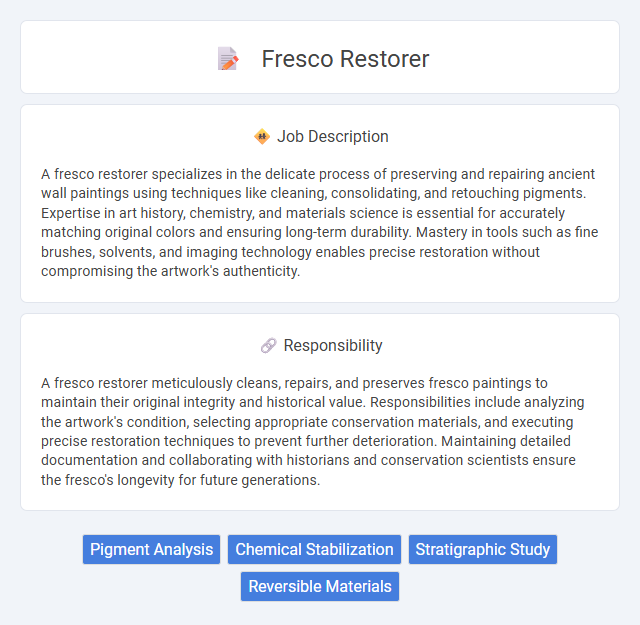
A fresco restorer specializes in the delicate process of preserving and repairing ancient wall paintings using techniques like cleaning, consolidating, and retouching pigments. Expertise in art history, chemistry, and materials science is essential for accurately matching original colors and ensuring long-term durability. Mastery in tools such as fine brushes, solvents, and imaging technology enables precise restoration without compromising the artwork's authenticity.
Individuals with a strong attention to detail and patience are likely well-suited for the job of a fresco restorer, given the meticulous nature of the work. Those who may struggle with prolonged concentration or who lack an interest in art history might find this role challenging. Physical stamina could also play a role, as the job might require working in varying positions for extended periods.
Qualification
Expertise in fine arts or art conservation is essential for a fresco restorer, often requiring a degree in art history, conservation, or a related field. Mastery of chemical compounds and materials used in fresco techniques enables precise restoration without damaging original artwork. Experience with historical frescoes and proficiency in advanced restoration tools and methods ensure faithful preservation of cultural heritage.
Responsibility
A fresco restorer meticulously cleans, repairs, and preserves fresco paintings to maintain their original integrity and historical value. Responsibilities include analyzing the artwork's condition, selecting appropriate conservation materials, and executing precise restoration techniques to prevent further deterioration. Maintaining detailed documentation and collaborating with historians and conservation scientists ensure the fresco's longevity for future generations.
Benefit
A fresco restorer is likely to benefit from developing specialized skills that enhance cultural preservation and artistic heritage. The role may offer opportunities for steady employment in museums, galleries, and conservation studios, which often seek experts in delicate restoration techniques. Exposure to historical art pieces might also increase job satisfaction and professional growth within the art restoration field.
Challenge
Fresco restorers likely face the challenge of working with fragile, centuries-old materials that require delicate and precise techniques to avoid further damage. The probability of encountering unpredictable degradation patterns means they must adapt their methods continuously to preserve the artwork's authenticity. Managing the balance between restoration and conservation often involves difficult decisions to maintain the fresco's original integrity while ensuring its longevity.
Career Advancement
Fresco restorers develop specialized skills in art conservation, enabling progression to senior conservator or project manager roles within museums and heritage organizations. Mastery of advanced techniques in pigment analysis and environmental control enhances job prospects and salary growth. Networking with art historians and participating in conservation research projects further accelerates career advancement opportunities.
Key Terms
Pigment Analysis
Fresco restorers specializing in pigment analysis utilize advanced techniques such as chromatography, X-ray fluorescence (XRF), and Raman spectroscopy to identify the chemical composition and original colors of historic pigments. Accurate pigment identification is crucial for selecting appropriate restoration materials that preserve the artwork's authenticity and longevity. Expertise in pigment analysis enables restorers to detect degradation processes and prevent further damage to fragile fresco surfaces.
Chemical Stabilization
Fresco restorers specialize in the chemical stabilization of ancient wall paintings, applying advanced techniques to prevent pigment degradation and substrate deterioration. They use tailored consolidants and inhibitors that strengthen the fresco's material structure while maintaining its original color integrity. Precise analysis of chemical composition guides the restoration process, ensuring long-term preservation through scientifically informed interventions.
Stratigraphic Study
Fresco restorers employ stratigraphic study to analyze and document each paint layer, revealing the chronological sequence of materials and interventions used on the artwork. This method allows precise identification of original pigments, overpaints, and previous restorations, ensuring accurate conservation decisions. Utilizing microscopic examination and chemical analysis, stratigraphic study supports the preservation of Fresco paintings by guiding targeted cleaning and stabilization techniques.
Reversible Materials
Fresco restorers specialize in using reversible materials to preserve and conserve delicate wall paintings, ensuring future restoration efforts remain possible without damage. These materials include water-soluble adhesives and removable consolidants that allow for non-invasive treatment and easy removal. Employing reversible techniques safeguards the original artwork's integrity while enabling ongoing maintenance and research.
 kuljobs.com
kuljobs.com